| |
|
SPOT
DIAGRAM |
| |
| Note the
extremely small, round star images-even
at the edge of the field of view. Only
the Advanced RC optical design can
produce such on and off-axis
performance. Before the new Meade RCX400
the serious astronomer would have to pay
more than three times the cost to get a
telescope that delivers this level of
professional observatory optical
performance. |
|
|
|
|
RCX400 PRICING
(All Prices Include Shipping & Handling
in the 50 United States) |
|
|
|
|
|
|
|
|
|
|
|
|
|
CANADIAN RESIDENTS
* Add 20% to the U.S. prices to
cover shipping and all Canadian
taxes.
* Add $50 processing fee for all
Canadian orders.
* Product(s) will be shipped to
your door.
* All prices are in U.S.Dollars. |
|
|
|
|
| |
|
MEADE RCX400 PRODUCT INNOVATIONS |
|
| |
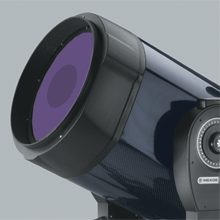 |
|
|
|
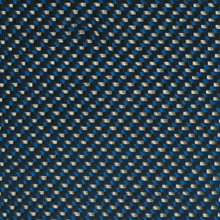 |
|
Advanced f/8
Ritchey-Chrétien Optics: The
Ritchey-Chrétien or RC optical design is well
known to discerning astrophotographers and is
the telescope optical design in many of the
leading professional observatories of the world.
Meade has taken its f/8 RC optical design to
another level by adding a corrector plate to
reduce residual astigmatism that is inherent in
the traditional optical design. In addition many
more design features were added to the RCX400
for the demanding researcher and imaging
enthusiast with telescopes available in
apertures of 10 inches, 12 inches, 14 inches,
and 16 inches. |
|
|
Series 5000
24mm 2" O.D.
Ultra Wide Angle Eyepiece:
Standard equipment on all RCX400 telescopes, the
Series 5000 24mm 2" O.D. Ultra Wide Angle
Eyepiece represents the ultimate in eyepiece
design and technology delivering extremely high
resolution, contrast and full-field sharpness
over an astounding 82° apparent field-of-view.
Only the highest quality materials were selected
to create this extraordinary eyepiece. The
designs required several different types of
exotic glass in order to achieve the highest
level of optical performance. |
|
|
New Carbon Graphite & Kevlar Tube:
The carbon graphite and Kevlar tube is a unique
light-weight, high strength material with
ultra-low expansion characteristics that will
maintain the spacing between the optics, so that
focus settings do not change with outside
temperature changes. This is a critical feature
to astrophotographers. Instead of forcing a
perfectly round shaped tube assembly, the tube
is shaped around the mechanisms and drive system
of the front focus and collimation assembly,
giving the RCX400 its unique look and style. |
|
| |
|
|
|
|
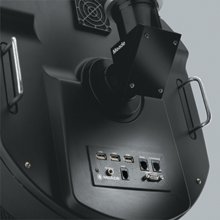 |
|
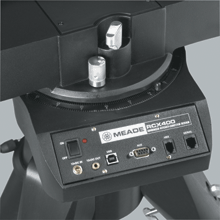 |
|
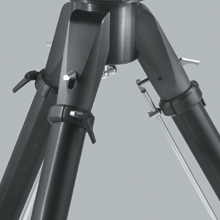 |
New Rear and Front Cell Architecture:
The front and back cells of the RCX400 are
designed to allow the maximum amount of air-flow
around the optics, in order to achieve the
quickest "cool down" times. To accelerate
cool-down time, a built-in fan on the rear cell
can be turned on and off through the AutoStar II
handbox. The rear cell additionally incorporates
a multi-port panel with 3 USB ports, a port for
an autoguider, AutoStar II handbox, illuminated
reticle, RS232, and one for future "Smart"
accessories. |
|
|
RCX400 Drive Base:
The multi-port panel of the RCX400 drive base
includes a special single High-Speed USB 2.0
input port allowing simultaneous control over
the telescope and either the Meade LPI or Deep
Sky Imager camera through Meade's AutoStar Suite
software. Additionally there are ports for a
power cord input, the AutoStar II handbox, a
DB-9 auxiliary port, 12v out power port, and
RS-232. Additionally the RCX400 includes the
familiar on/off switch and LED power light
indicator. |
|
|
New
Ultra-Stable Tripod:
Standard equipment for RCX400 10", 12", and 14"
telescopes, the patent pending trigger release
leg locks of the Ultra-Stable tripod are
positioned at the top of the tripod legs for
easy access. |
|
|
| |
The RCX Advanced Ritchey-Chrétien Optical System
It is generally accepted that the Ritchey-Chrétien or Classical
RC system is the premiere optical design for medium to large
aperture astronomical telescopes. The primary benefit of a
Classical RC is the fact that it is an aplanatic design which
means it is coma-free. Coma is an optical aberration that causes
star images to appear comet like with tails that point away from
the center of the field of view. The further from the center,
the larger the effect. Fast Newtonians suffer from this
aberration the most, followed by other reflecting optical
systems of various designs. The Schmidt-Cassegrain or
Schmidt-Newtonian design typically has ½ the coma of a Newtonian
of the same focal length. The Classical RC design uses a
hyperbolic primary mirror and a hyperbolic secondary mirror to
create an aplanatic optical system which has no coma. This
system produces small round star images all the way to the edge
of the field of view.
Meade’s engineering team recognized the advantages of the
Classical RC design but explored the possibility of using
Meade’s unique engineering and manufacturing expertise to
improve on the basic design. The result is the RCX optical
system which is also an aplanatic, coma-free design with small
round star images to the edge of the field. The RCX design is
very similar to the Classical RC and achieves the same benefits
by using a hyperbolic secondary with a new advanced front
corrector plate and primary mirror that together perform as a
hyperbolic primary. This design has several advantages over the
Classical RC design.
- The RCX eliminates the secondary mirror holder support
vanes (spider) that cause diffraction spikes. Because almost
all reflecting telescopes produce diffraction spikes, many
people are used to seeing them and don’t consider them an
aberration. But in reality, they are a large distortion that
reduces image contrast, lowers resolution and presents an
unrealistic view of the sky to the eye or the astro-imager.
- The RCX design reduces the amount of astigmatism that is
inherent in the Classical RC design.
- The RCX, due to the front corrector plate, is a closed
tube design. This keeps the primary optical components
protected from dust, moisture and other contaminates that
might fall on the optical surfaces of the primary and
secondary mirrors.
While the RCX optical system is significantly more expensive to
manufacture than a Classical RC, it was chosen because of its
superior performance (i.e., no diffractions spikes, reduced
astigmatism and closed tube). Due to Meade's years of experience
in designing and manufacturing sophisticated corrector plates
and optical systems, we are in a position that very few, if any,
other companies enjoy. Applying this expertise and Meade's
resources, we are able to produce this advanced optical system
at a fraction of the price that other companies would have to
charge, if they could produce it at all. |
| |
Precision
GPS Alignment:
Telescope alignment is accomplished automatically using
signals from the Global Positioning System (GPS), a
satellite system that enables extremely precise
communication to the telescope of the observer's
latitude and longitude, as well as local time.
Integrated True-Level and North electronic sensors in
combination with a high-sensitivity Sony GPS receiver
located in the left-hand fork arm result in accurate
telescope alignment to the sky at the touch of a button:
Just press the ENTER button on the Autostar II hand
controller and watch as the telescope measures level,
points North, and slews at 8°/sec. to its first
alignment star. Magnetic declination compensation
designed into the telescope software automatically
engages during the alignment process.
Software Downloads and
Satellite Tracking:
The software included in Meade RCX400 telescopes is
under continuous factory review; updates to this
software are published at regular intervals on Meade's
website. Importantly, the latest software version, as
well as custom and updated guided tours, comet and
asteroid positions, may be downloaded in minutes from
Meade's website. Additionally, current Earth satellite
orbital data (including the International Space Station,
Space Shuttle, etc.) may be downloaded; the telescope
then automatically acquires and tracks the satellite at
the correct tracking rate. The telescope's flash memory
may be upgraded through one of the RS-232 ports with new
software or data as they become available on Meade's
website.
Expanded Database and
Larger User Memory:
The RCX400 database has been expanded over the standard
library of the LX200GPS to include 180,000 objects. In
addition to more stars from the Hipparchos/Tycho
catalog, we have added::
• The popular "Lunar 100" with the finest features to
see and image on the Moon
• A subset of the finest visual doubles from the
Washington Double Star Catalog
• The PK Catalog of Planetary Nebulae
• The Hickson Catalog of Dense Galaxy Clusters
• The Gleason Catalog of Nearby Stars
• The Landolt Catalog of Photometric Standard Stars
• The Sharpless Catalog of HII Regions
Laser Aligned, Fixed Primary Mirror:
The primary mirror is laser aligned to the true optical
path, then float bonded in place. It is fixed, but
literally floats on a layer of adhesive that results in
zero stress to the glass and no distortion to the optics
(unlike mirror cells or floating point pads). There is
no mirror movement.
Field Operation:
RCX400 scopes operate from eight C-cells neatly stored
inside the fork arms. Alternately, telescope powering
may be effected from an automobile cigarette lighter
plug (using the optional #607 Power Cord) or from a
standard home outlet (using the new optional AC
Adapter).
#929 2" Diagonal with UHTC:
Standard equipment on all RCX400 telescopes, attaches to
the rear cell of and permits the use of wide-field 2"
O.D. eyepieces. Each diagonal includes a Meade
optical-flat mirror of Pyrex glass, UHTC-coated for
maximum reflectivity.
Built-In Dew Heater:
Instead of wrapping a heating element around the
telescope's optical tube assembly to send heat through
the telescope's front cell to prevent dew from forming
on the corrector plate, the RCX400 incorporates a
nickel-chromium wire heating element that is in contact
with the glass of the corrector plate that quickly,
efficiently, and safely sends heat through lens using
the lowest power drain possible. With two onboard
temperature sensors, one to measure ambient temperature
(placed inside the fork arm) and one to measure the
temperature of the corrector plate, the RCX400 can be
set to have the built-in dew heater keep the corrector
plate warmed to a user-defined setting above ambient
temperature. By only using the dew heater precisely when
needed, battery usage is managed to its optimum. All
functions to operate the dew heater are controlled by
the AutoStar II handbox. |
|
Precision
Encoder-Measured
Digital Focusing:
With a laser aligned primary mirror fixed in position,
focusing is performed electronically and digitally by
precisely moving the entire front cell in increments as
fine as 1/100 of a millimeter. Digital readout of the
focus position can be read on the telescope's AutoStar
II handbox. There are 4 different focusing speeds from
fine to fast. Since the process is accomplished without
moving the primary mirror, the entire assembly is
virtually free from image shift.
High-Precision
Pointing (HP) Capability:
Meade RCX400 models permit the most accurate pointing
capability ever offered in a commercial telescope. Now
you can command the telescope to GO TO an object located
on the opposite side of the sky (for example, a distance
of 120 degrees in sky-angle) and, in conjunction with
the telescope's unique SYNC command, the RCX400 locates
and centers the desired object. HP capability is
accessible in either the altazimuth or equatorial
orientations.
Precision Electronic Optical Collimation:
Collimating a Cassegrain telescope has never
been easier. RCX400 owners will make precision
collimation adjustments to the secondary mirror of the
telescope by using the arrow keys of AutoStar II handbox,
allowing a single person to simultaneously make
adjustments and see the results. In addition, Meade
precision collimates the optics at the factory and then
sets that position as the default setting. So in the
case where one may make a mistake in making a
collimation adjustment, the default setting can always
be used.
Smart Drive Permanent Periodic
Error Correction (PPEC):
Included as standard equipment, the Smart Drive permits
a professional level of drive-rate precision. No longer
are large systems required, worm gear when smaller gears
coupled to Smart Drive software can achieve periodic
errors of 5 arc secs or less-an observatory standard of
precision. All worm/worm-gear combinations, no matter
how well made, have minor inaccuracies that manifest
themselves as periodic errors in the telescope tracking
rate, with the period dependent on the worm's rate of
rotation. To program the Smart Drive the observer guides
on an object visually, making corrections with the
handbox controller. The software then remembers these
corrections, stores them in memory, and in the future
automatically compensates for the periodic errors of the
gear system. Smart Drive user programming is stored in
the telescope's computer memory forever, independently
of any power source, unlike other periodic error
correctors that must be reprogrammed each time you use
the system. The Smart Drive can be erased, updated, or
even averaged with future programming at the user's
option. The significant value of the Smart Drive is
immediately appreciated during long-exposure
astrophotography, where the resulting low periodic error
of the system enables relaxed guiding with a minimum of
handbox corrections. In CCD imaging, where short
exposures of deep-space objects are often all that is
required for stunning results, the Smart Drive often
permits imaging without any guiding requirements at all.
Heavy-Duty Fork Mounts:
RCX400 fork mounts are the strongest, most rigid
mountings ever made available for telescopes of these
apertures. Fork arms, are both longer and stronger. This
allows the 10", 12" and 14" scopes to go all the way to
90 degrees declination on a wedge, allowing you to reach
the horizon. The increased fork size also gives more
back clearance to allow imaging all the way to the pole
with most cameras. DC-servo-motor-controlled (12v DC)
worm gear drives with almost two hundred selectable
drive speeds, combined with the Meade Smart Drive on
both telescope axes, permit observatory-level precision
in tracking, guiding, and slewing. Photo-guide speeds
are selectable from 0.01x to 1.0x sidereal, in
increments of 0.01x; fast-slew speeds are selectable
from 1°/sec. to 8°/sec. in 0.1°/sec. increments. Use the
8°/sec. speed for rapid motion of the telescope across
the skies; once near the target, switch instantly to a
speed of 1.5°/sec. or 3°/sec. for centering in the
viewfinder. Observing in the main telescope, use the 16x
or 64x sidereal speed to place the object in the center
of the field.
|
|
Computer Optimized
Internal Baffling: Unlike traditional Schmidt-Cassegrain
designs, the primary mirror moves along a baffle tube in
order to achieve focus, Meade's RCX400 primary mirror is
mounted independent of the baffle tube. This allowed
Meade's engineers to take full advantage of the baffle
design to create full stray light cut-off performance,
in order to produce the maximum contrast. Additionally
the secondary baffle, machined of aluminum with its
distinctive outer knife-edges further minimizes stray
light in the optical path.
RCX400 Balanced Drives:
The drive mechanisms of many telescopes can be compared
to the movements of fine chronometer watches. First
utilized on the 14" LX200GPS, the RCX worm block design
incorporates a unique balanced loading system to the
keep worm and worm gear in the optimum contact position,
regardless of the load stress that is normally
encountered as the telescope is moved from one position
of the sky to the next. The result is improved drive
performance, with superior centering and slewing
characteristics. RCX400 Balanced Drive assemblies are on
both the RA and Dec. axes.
Focus Position Presets:
By setting up to 9 focus positions, RCX400 owners can
customize perfect focus from observer to observer with
different eyesight (similar to the custom settings in
luxury cars to change the mirror, seat, and steering
wheel settings from one driver to another). The feature
is also very useful when using switching to various
eyepiece and Barlow lens combinations or from a visual
setup to a camera setup.
UHTC Coatings:
Standard on all RCX400 telescopes, the importance of
Meade's proprietary UHTC group becomes apparent when
comparing total telescope light transmission, or
throughput, caused by the multiplier, or compounding,
effect of the four optical surfaces. With each optical
surface contributing significantly to telescope light
throughput, the effect of all four surfaces combined is
indeed dramatic. At the H-a wavelength of 656nm., total
transmission increases from 76.7% to 88.5%, an increase
of 15.4%; at the helium wavelengths of 588nm. and 469nm.
- strong emission lines in hot planetary nebulae - total
telescope transmission increases by 13.8% and 16.8%,
respectively; at the two nitrogen II lines of 655nm. and
658nm. and at the sulfur II line of 673nm., transmission
is increased by 16%. Averaged over the entire visible
spectrum (450nm. to 700nm.), total light transmission to
the telescope focus increases by about 15%.
More
Info about UHTC
Smart Mount:
Revolutionary Smart Mount technology is standard
equipment on all RCX400 telescopes. Smart Mount improves
the pointing accuracy of your RCX400's telescope's "Go
To" system with the following features:
• Constantly improved pointing accuracy with every
object centered and sync'ed.
• Works with both equatorial and altazimuth
configurations.
• Simple routine to refine pointing accuracy for the
entire sky with your equipment configuration and
alignment.
• Refined pointing data can be saved and reused for
permanent and portable setups.
Altazimuth and Equatorial Operation:
For all visual observing applications, for lunar and
planetary photography, and for many CCD imaging
applications, Meade RCX400 may be set up in the
altazimuth mode - just attach the telescope's drive base
directly to the tripod, use the GPS alignment procedure,
and the telescope's computer actuates 2-axis tracking
that keeps objects precisely centered in the field, even
at high powers, during the entire observing session. For
long-exposure astrophotography altazimuth-induced field
rotation requires the new Superwedge or the #1220 (for
10", 12", and 14" models) or the #1222 (for 16" models)
Field De-rotator, either of which may be purchased
separately. |
|
| |
| |
KEY
FEATURES
GPS & Level-North Alignment System
Upgraded AutoStar II Controller
Cooling Fan
Smart Mount™
Smart Drive™ (Permanent Periodic Error Correction)
Oversized Primary Mirror
24mm Series 5000™ Ultra Wide Angle Eyepiece
Ultra High Transmission Coatings (UHTC) |
|
SPECIFICATIONS |
|
|
|
|
|
Aperture |
10" |
12" |
14" |
16" |
| Focal Length |
2032mm |
2438mm |
2845mm |
3251mm |
| Focal
Ratio |
f/8 |
f/8 |
f/8 |
f/8 |
| Series 5000™ Eyepiece |
24mm UWA |
24mm UWA |
24mm UWA |
24mm UWA |
| UHTC™ |
Included |
Included |
Included |
Included |
| Accessory Kits |
Click
Here |
Click Here |
Click Here |
Click Here |
|
|
|

